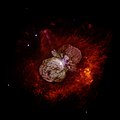Fichièr:Eta Carinae.jpg
Aparença

Talha d'aquesta previsualizacion: 600 × 599 pixèls. Autras resolucions : 240 × 240 pixèls | 480 × 480 pixèls | 769 × 768 pixèls | 1 025 × 1 024 pixèls | 2 015 × 2 013 pixèls.
Fichièr d'origina (2 015 × 2 013 pixèl, talha del fichièr: 163 Ko, tipe MIME: image/jpeg)
Istoric del fichièr
Clicar sus una data e una ora per veire lo fichièr tal coma èra a aqueste moment
| Data e ora | Miniatura | Dimensions | Utilizaire | Comentari | |
|---|---|---|---|---|---|
| actual | 18 decembre de 2017 a 09.41 |  | 2 015 × 2 013 (163 Ko) | The NMI User | Reverted to version as of 14:14, 1 May 2008 (UTC) |
| 13 març de 2017 a 14.45 |  | 3 000 × 2 998 (1,18 Mo) | Leogorgon | larger file size | |
| 1 mai de 2008 a 14.14 |  | 2 015 × 2 013 (163 Ko) | Vol de nuit | {{Information |Description=(NASA News Release) A huge, billowing pair of gas and dust clouds are captured in this stunning NASA Hubble Space Telescope image of the supermassive star Eta Carinae. Using a combination of image processing techniques (ditheri |
Paginas que contenon lo fichièr
I a ges de pagina que compòrta un ligam vèrs aqueste imatge.
Usatge global del fichièr
Los autres wikis seguents utilizan aqueste imatge :
- Utilizacion sus da.wikipedia.org
- Utilizacion sus en.wikipedia.org
- Star
- Eta Carinae
- Wikipedia:Selected anniversaries/March 11
- Wikipedia:Today's featured article/March 2017
- Wikipedia:WikiProject Wikipack Africa Content/Wikipedia:Showcase
- Wikipedia:WikiProject WikiFundi Content/Eta Carinae
- Wikipedia:Today's featured article/requests/Eta Carinae
- Wikipedia:Today's featured article/March 12, 2017
- Wikipedia:Main Page history/2017 March 12
- Wikipedia:WikiProject WikiFundi Content/Wikipedia:Showcase
- Wikipedia:Main Page history/2022 March 11
- Wikipedia:Main Page history/2022 March 11b
- Wikipedia:Main Page history/2023 March 11
- Wikipedia:Main Page history/2023 March 11b
- User:2003 LN6/sandbox/Eta Carinae variable
- List of luminous blue variable stars
- Utilizacion sus en.wikiversity.org
- User:Marshallsumter/Radiation astronomy2/Visuals
- User:Marshallsumter/Radiation astronomy2/Violets
- Stars/Astronomy
- User:Marshallsumter/Radiation astronomy2/Violets/Quiz
- Stars/Sun/Astronomy/Quiz
- User:Marshallsumter/Radiation astronomy/Courses/Principles/Hourly 2
- User:Marshallsumter/Radiation astronomy/Courses/Principles/Final quiz
- Draft:Original research/Io/Quiz
- Titan/Quiz
- Stars/Solar systems/Quiz
- Moon/Quiz
- Earth/Quiz
- User:Marshallsumter/Radiation astronomy/Colors/Quiz
- Volcanoes/Io/Quiz
- Stars/Violets
- User:Marshallsumter/Radiation astronomy2/Stars
- Stars/Violets/Quiz
- Utilizacion sus es.wikipedia.org
- Utilizacion sus fr.wikipedia.org
- Utilizacion sus hi.wikipedia.org
- Utilizacion sus it.wikibooks.org
- Utilizacion sus la.wikipedia.org
- Utilizacion sus mk.wikipedia.org
- Utilizacion sus ms.wikipedia.org
- Utilizacion sus my.wikipedia.org
- Utilizacion sus oc.wikipedia.org
- Utilizacion sus ru.wikipedia.org
- Utilizacion sus sk.wikipedia.org
- Utilizacion sus sr.wikipedia.org
- Utilizacion sus th.wikipedia.org
Veire l'utilizacion globala d'aqueste fichièr.

